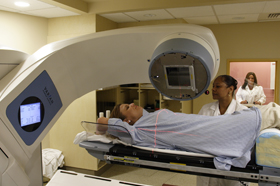ASTRO Updates Partial Breast Irradiation Guidelines
 The American Society for Radiation Oncology (ASTRO) issued today a patient-centered clinical guideline on partial breast irradiation in early-stage invasive breast cancer or ductal carcinoma in situ (DCIS). For the guideline, experts in breast cancer compiled evidence—including several recently published large, randomized clinical trials—to provide guidance on which patients can benefit from partial breast radiation, as well as best practices to deliver the treatment effectively.
The American Society for Radiation Oncology (ASTRO) issued today a patient-centered clinical guideline on partial breast irradiation in early-stage invasive breast cancer or ductal carcinoma in situ (DCIS). For the guideline, experts in breast cancer compiled evidence—including several recently published large, randomized clinical trials—to provide guidance on which patients can benefit from partial breast radiation, as well as best practices to deliver the treatment effectively.
Breast cancer is the most common malignancy treated with radiation therapy in the United States and the leading cause of cancer incidence worldwide. Patients diagnosed with early-stage breast cancer—the most common presentation of the disease—often are eligible for breast-conserving therapy, an alternative to breast removal that combines surgery to remove the tumor with radiation therapy to reduce the likelihood it will return. With partial breast radiation, the radiation dose is delivered just to the part of the breast where the tumor was removed, offering a more localized alternative to whole breast irradiation that patients report is associated with lower out-of-pocket costs and less time away from work.
Since ASTRO last issued recommendations for partial breast radiation in 2017, multiple randomized trials have published results comparing clinical outcomes with partial breast and whole breast radiation, consistently finding no significant differences in recurrence in the same breast, overall survival or cancer-free survival, as well as similar or improved side effects with the partial breast treatment. Evidence from these clinical trials was included in a systematic review conducted by the Agency for Healthcare Research and Quality (AHRQ) to develop the guideline.
“There have been more than 10,000 women included in these randomized controlled trials, with 10 years of follow-up showing equivalency in tumor control between partial breast and whole breast radiation for appropriately selected patients,” said Simona F Shaitelman, MD, EdM, vice chair of the guideline task force and a professor of breast radiation oncology at the University of Texas MD Anderson Cancer Center in Houston. “These data should be driving a change in practice, and partial breast radiation should be a larger part of the dialogue when we consult with patients on decisions about how best to treat their early-stage breast cancer.”
The task force and AHRQ review also addressed the technical aspects of partial breast radiation, including techniques and best practices to deliver partial breast radiation.
“We hope that by laying out the evidence from these major trials and providing guidance on how to administer partial breast radiation, the guideline can help more oncologists feel comfortable offering this option to their patients as an alternative to whole breast radiation,” Janice A Lyons, MD, chair of the guideline task force and a professor of radiation oncology at the University Hospitals Seidman Cancer Center in Cleveland. “For example, we discuss data linking certain fractionation schedules with better cosmetic outcomes, to help providers achieve positive results for their patients.”
Full recommendations and supporting evidence are provided in the guideline; key recommendations are as follows:
- For patients with early-stage, node-negative invasive breast cancer, partial breast radiation is strongly recommended as an alternative to whole breast radiation if the patient has favorable clinical features and tumor characteristics, including grade 1-2 disease, estrogen receptor (ER)-positive status, age 40 or older and small tumor size. It is conditionally recommended if the patient has an indicator of higher recurrence risk, including grade 3 disease, ER-negative histology or larger tumor size. It is not recommended for patients with positive lymph nodes, positive surgical margins or germline BRCA1/2 mutations or those who are younger than 40, and it is conditionally not recommended for patients with less favorable risk features (e.g., lymphovascular invasion or lobular histology), due primarily to the lack of robust data on these patient subsets in published randomized trials.
- The recommendations for patients with DCIS align with those for early-stage breast cancer: partial breast radiation is strongly recommended as an alternative to whole breast radiation for patients with favorable clinical and tumor features outlined in the guideline; conditionally recommended for those with higher grade disease or larger tumors; and not recommended for patients with positive surgical margins, BRCA mutations or age <40.
- Recommended techniques for partial breast radiation include 3-D conformal radiation therapy (3-D CRT), intensity modulated radiation therapy (IMRT) and multi-catheter interstitial brachytherapy, based on published research showing similar long-term rates of ipsilateral breast recurrence (IBR) compared to whole breast radiation. Single-entry catheter brachytherapy is conditionally recommended. Intraoperative radiation therapy (IORT) techniques, including electron IORT and photon (kV) IORT without whole breast radiation, are not recommended unless as part of a clinical trial or multi-institutional registry.
- The guideline also outlines the optimal dose-fractionation regimens, target volume delineation and treatment planning parameters for different partial breast radiation techniques, with particular attention to clinical and cosmetic side effects. A daily or every-other-day course of partial breast radiation is recommended over twice-daily regimens.
The guideline was based on a systematic literature review and comparative effectiveness evidence review conducted by AHRQ, which was funded by the Patient-Centered Outcomes Research Institute (PCORI). The AHRQ review included articles published through June 2022; additional details are available on the AHRQ website.
The multidisciplinary guideline task force included academic and community-based radiation, medical and surgical oncologists, a medical physicist and a patient representative. The guideline was developed in collaboration with the American Society of Clinical Oncology and the Society of Surgical Oncology and is endorsed by the Canadian Association of Radiation Oncology, the European Society for Radiotherapy and Oncology, and the Royal Australian and New Zealand College of Radiologists.